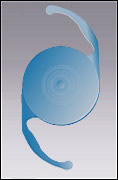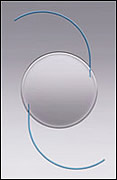Multifocal IOL Implants have become increasingly popular among patients because of the likelihood they will no longer be required to wear glasses or contacts after surgery. Once you have made the decision to undergo cataract surgery with your eye doctor you will have a series of decisions to make related to the type of artificial lens implant you will have. Up until recently everyone who had cataract surgery received a monofocal lens implant. This lens enabled for vision of one distance, typically distances far away. With new innovations a better lens is now available. These lenses are referred to as premium lenses and come in various formats or types.
A Multifocal Lens Implant is a lens that has a different power in the center of the lens and another power in the border of the lens so that vision can be focused for far or near out of the same eye. These different zones of lens power work together to provide the eye with near and distance vision. The lenses are made of plastic or silicone materials and placed permanently in the eye after removal of the eye’s natural lens. Subsequently, a Multifocal Lens can help correct Nearsightedness, Farsightedness, and Presbyopia.
The leading advantage offered by multifocal lenses is the opportunity to become less reliant on reading glasses for near activities. For many people, presbyopia, the loss of the eye’s ability to zoom from distant to near objects, is very frustrating and becomes worse with age. For people discontented by the need for reading glasses, multifocal lenses offer a good alternative.
Multifocal IOL lens implants enable patients to see at near far and intermediate distances after surgery. The 2 major brand names in this category are the The AcrySof® ReSTOR® IOL by Alcon and the Tecnis® by AMO. (Recently acquired by Abbott). With a multifocal IOL the central portion of the lens has a series of steps that are carved in a very precise arrangement with varying step heights and distances between steps. Each of the steps of this diffractive optic bends the incoming light differently; creating a near focus that is quite separated from the distance focus formed by the remaining refractive portion of the lens. This large separation between the two images allows for less artifacts or distortion in either of the images, providing good quality of vision at both distance and near.
Dr. Reeves will go over the pros and cons of each type of multifocal lens with you to help find the one must suitable for your eyes.



